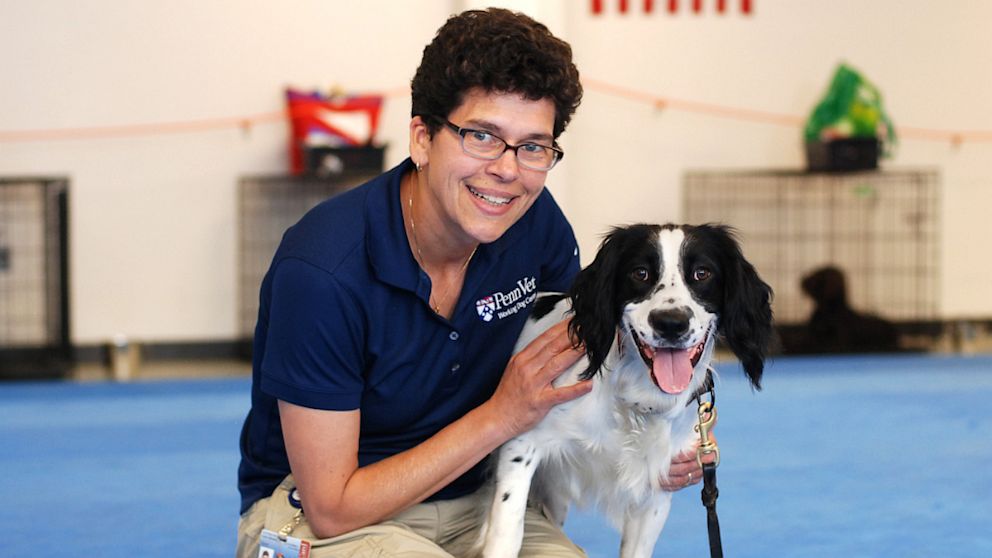Sniffing Out Cancer: Dogs Are the Pros in This Lab
Aug. 9, 2013 — -- Ohlin Frank, a chocolate lab whose focus has the intensity of Sherlock Holmes, is only on his fourth training session at Penn Vet Working Dog Center, but he has been able to detect ovarian cancer tissue 100 percent of the time.
He and his fellow trainee, McBaine Chamberlain, a spunky springer spaniel who is a bit more excitable, are part of an interdisciplinary research project at the University of Pennsylvania's to help scientists discover a chemical footprint that might lead to earlier diagnostic tests to save human lives.
They are among 15 carefully bred detection dogs learning to sniff out explosives, drugs and missing people. And now, they will use their keen sense of smell to identify the earliest odor of ovarian cancer, a silent killer that is often diagnosed too late.
Dogs tumors give clues to human breast cancer.
Ovarian cancer will kill more than 14,000 women in the United States this year and 22,000 new cases will be diagnosed, according to the National Cancer Institute.
But doctors still don't have a good diagnostic tool for ovarian cancer, so they hope the dogs and their keen sense of smell can lead them toward one.
Researchers study psychedelics for ovarian cancer.
Cancer cells leave a detectable biomarker, just as asparagus can affect the smell of urine when eaten.
Within two years, Penn Vet founder and executive director Cynthia M. Otto hopes the dogs can be trained to narrow down a specific odor so scientists can design an inexpensive and less-invasive blood test to catch ovarian cancer while it's still treatable.
"All dogs are really good at sniffing, but part of what gives them a huge advantage over us is the surface area of the olfactory receptors," Otto told ABCNews.com as the dogs began their "search game" during a recent day's work at the lab.
Max the dog survives Hurricane Sandy and owner's death.
After eight weeks of foundation training in obedience and agility, the dogs had already been introduced to the cancer tissue smell and were taught to sit when they found it.
"We had a party and played with them with toys," Otto said. "Then the game becomes, 'What do I have to do to get the toy?'"
"They get really excited and quickly figure out what they have to do to get their toys," she added.
Engineering students at Penn designed a large wheel with paint cans on the end of each spoke. Only one of the cans holds cancer tissue.
Ohlin's handler, Jonathan Ball, offered him a tug toy and praised the animal as the two roughhoused together. Soon, Ball tossed the toy to a second handler, Annemarie DeAngelo, who hid it in her shirt, then pretended to place the toy in each of the buckets.
DeAngelo swirled the wheel to mix up the empty cans with the cancer sample, as the handlers encouraged Ohlin, "Go get it, good boy."
And he did, every time, sitting patiently, awaiting his tug toy at the right bucket.
In previous research, dogs have been useful in detecting cancers of the breast, prostate, colorectal, bladder and skin. Penn Vet dogs Papa Bear, a chocolate Labrador retriever, and Bretagne, a golden retriever, are already helping alert diabetics when their sugar levels are too high or too low.
Otto, a veterinarian and researcher, founded the Penn Vet Working Dog Center in 2007 after spending 10 days right after 9/11 caring for the search-and-rescue dogs deployed in the burning rubble at the fallen World Trade Center.
"Originally, we went hoping for live humans," she said. "The rescue workers on the site did an incredible job of getting people out, but what was left were not survivors."
The terrorist attacks deeply affected Otto, and so now she is on a mission to use man's best friend to help humans.
"It's the intersection of how dogs help people," said Otto, the center's executive director. "It's a big place with lots of great aspirations, many of them already materializing."
The detection dogs -- both male and female, aged 8 to 11 months -- are each named for 9/11 dogs and their handlers and undergo twice-a-day training, five days a week.
The research is an interdisciplinary effort between the Penn Vet Working Dog Center and three arms of the University of Pennsylvania -- the physics department, the division of gynecologic oncology and the Monell Chemical Senses Center. It uses an $80,000 grant from Kaleidoscope of Hope Ovarian Cancer Foundation, but gets no funding from the university.
The grant funds three parallel studies: the biological one with dogs; an organic chemistry effort to create an artificial nose; and nanotechnology to develop a computerized screening instrument.




